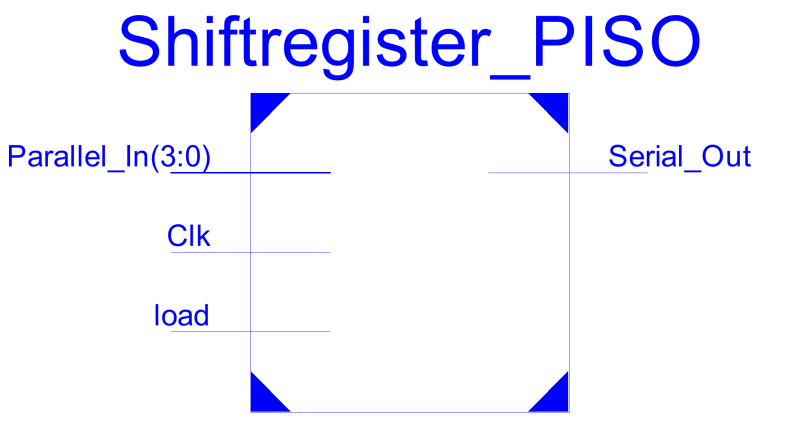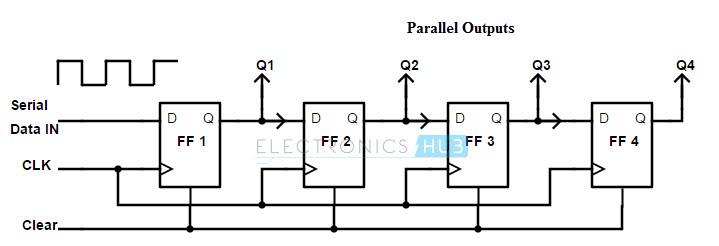Jul 28, 2013. 4 Bit Comparator Design Verilog CODE. Serial OUT Shift Register using Behavior Modeling Style. Parallel IN - Serial OUT Shift Register.v. Serial OUT Shift Register using Behavior Modeling Style. 4 Bit Comparator Design Verilog CODE. Parallel IN - Serial OUT Shift Register.v.
The 74LV165A is an 8-bit parallel-load or serial-in shift register with complementary serial outputs (Q7 and Q7) available from the last stage. When the parallel-load input (PL) is LOW, parallel data from the inputs D0 to D7 are loaded into the register asynchronously. When input PL is HIGH, data enters the register seria lly at the input DS. The following code models a four-bit parallel in shift left register with load and shift enable signal. Module Parallelinserialoutloadenablebehavior(input Clk, input ShiftIn, input 3:0 ParallelIn, input load, input ShiftEn, output ShiftOut, output. IC 74498 8-bit bidirectional shift register with parallel inputs and three-state outputs. IC 74671 4-bit bidirectional shift register. IC 74673 16-bit serial-in serial-out shift register with output storage registers. IC 74674 16-bit parallel-in serial-out shift register with three-state outputs. In these ICs, mostly used are.
In, a shift register is a cascade of, sharing the same, in which the output of each flip-flop is connected to the 'data' input of the next flip-flop in the chain, resulting in a circuit that shifts by one position the ' stored in it, 'shifting in' the data present at its input and 'shifting out' the last bit in the array, at each transition of the clock input. More generally, a shift register may be multidimensional, such that its 'data in' and stage outputs are themselves bit arrays: this is implemented simply by running several shift registers of the same bit-length in parallel.

Shift registers can have both and inputs and outputs. These are often configured as 'serial-in, parallel-out' (SIPO) or as 'parallel-in, serial-out' (PISO). Dashlane Cracked.
There are also types that have both serial and parallel input and types with serial and parallel output. There are also 'bidirectional' shift registers which allow shifting in both directions: L→R or R→L.
The serial input and last output of a shift register can also be connected to create a 'circular shift register'. Contents • • • • • • • • Serial-in serial-out (SISO) [ ] Destructive readout [ ] 0 0 0 0 1 0 0 0 1 1 0 0 0 1 1 0 1 0 1 1 0 1 0 1 0 0 1 0 0 0 0 1 0 0 0 0 These are the simplest kind of shift registers.

The data string is presented at 'Data In', and is shifted right one stage each time 'Data Advance' is brought. At each advance, the bit on the far left (i.e. 'Data In') is shifted into the first 's output. The bit on the far right (i.e. Data Out) is shifted out and lost.
Universal Shift Register Verilog Code
The data are stored after each on the 'Q' output, so there are four storage 'slots' available in this arrangement, hence it is a 4-bit Register. To give an idea of the shifting pattern, imagine that the register holds 0000 (so all storage slots are empty). As 'Data In' presents 1,0,1,1,0,0,0,0 (in that order, with a pulse at 'Data Advance' each time—this is called clocking or strobing) to the register, this is the result. The right hand column corresponds to the right-most flip-flop's output pin, and so on. So the serial output of the entire register is 00001011. It can be seen that if data were to be continued to input, it would get exactly what was put in (10110000), but offset by four 'Data Advance' cycles. This arrangement is the hardware equivalent of a.
Also, at any time, the whole register can be set to zero by bringing the reset (R) pins high. This arrangement performs destructive readout - each datum is lost once it has been shifted out of the right-most bit. Serial-in parallel-out (SIPO) [ ]. This configuration allows conversion from serial to parallel format. Data input is serial, as described in the SISO section above. Once the data has been clocked in, it may be either read off at each output simultaneously, or it can be shifted out. In this configuration, each flip-flop is.
All flip-flops operate at the given clock frequency. Each input bit makes its way down to the Nth output after N clock cycles, leading to parallel output. In cases where the parallel outputs should not change during the serial loading process, it is desirable to use a latched or output.
In a latched shift register (such as the ) the serial data is first loaded into an internal buffer register, then upon receipt of a load signal the state of the buffer register is copied into a set of output registers. In general, the practical application of the serial-in/parallel-out shift register is to convert data from serial format on a single wire to parallel format on multiple wires. Parallel-in serial-out (PISO) [ ] This configuration has the data input on lines D1 through D4 in parallel format, D1 being the most significant bit. To write the data to the register, the Write/Shift control line must be held LOW.
To shift the data, the W/S control line is brought HIGH and the registers are clocked. The arrangement now acts as a PISO shift register, with D1 as the Data Input. However, as long as the number of clock cycles is not more than the length of the data-string, the Data Output, Q, will be the parallel data read off in order. Toshiba TC4015BP - Dual 4-Stage Static Shift Register (with serial input/parallel output) One of the most common uses of a shift register is to convert between serial and parallel interfaces. This is useful as many circuits work on groups of bits in parallel, but serial interfaces are simpler to construct.
4 Bit Shift Register Verilog
Shift registers can be used as simple delay circuits. Several bidirectional shift registers could also be connected in parallel for a hardware implementation of a. SIPO registers are commonly attached to the output of microprocessors when more pins are required than are available. This allows several binary devices to be controlled using only two or three pins, but slower than parallel I/O - the devices in question are attached to the parallel outputs of the shift register, then the desired state of all those devices can be sent out of the microprocessor using a single serial connection. Similarly, PISO configurations are commonly used to add more binary inputs to a microprocessor than are available - each binary input (i.e. A button or more complicated circuitry) is attached to a parallel input of the shift register, then the data is sent back via serial to the microprocessor using several fewer lines than originally required.

